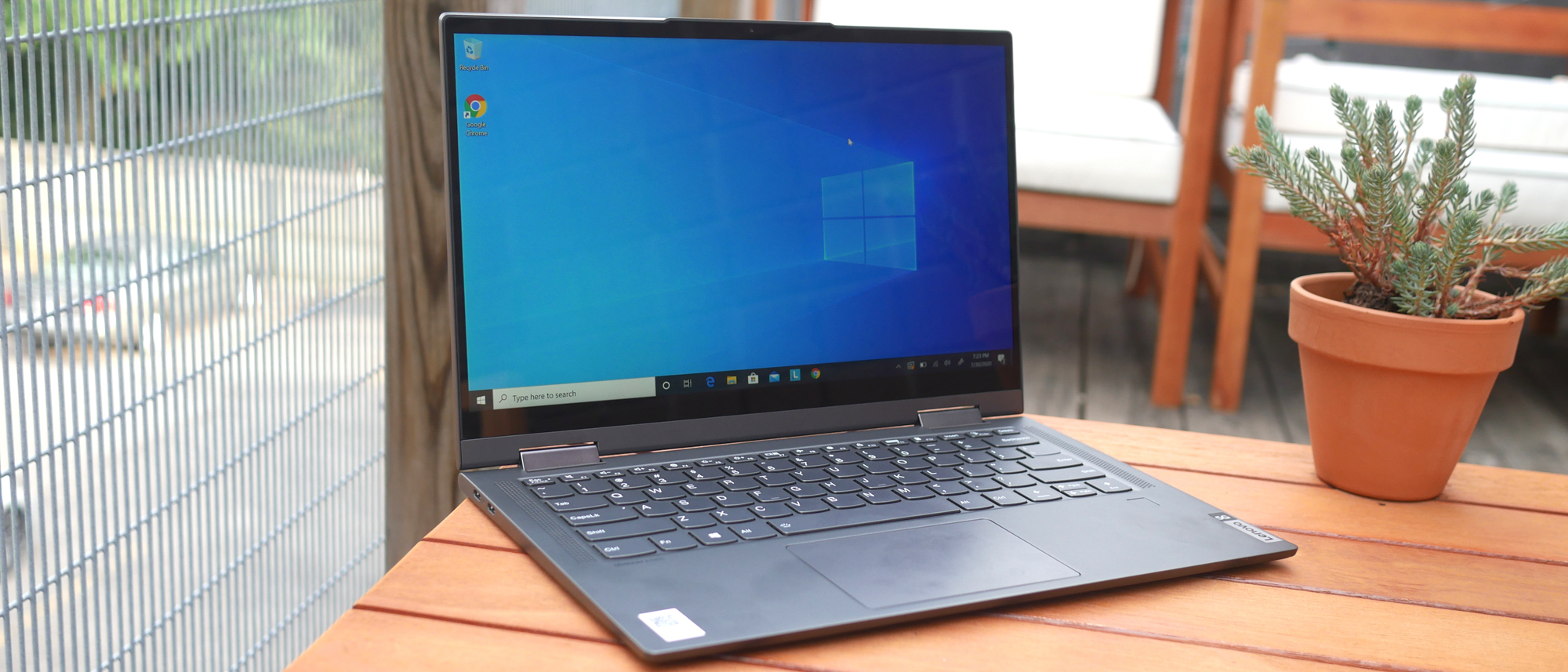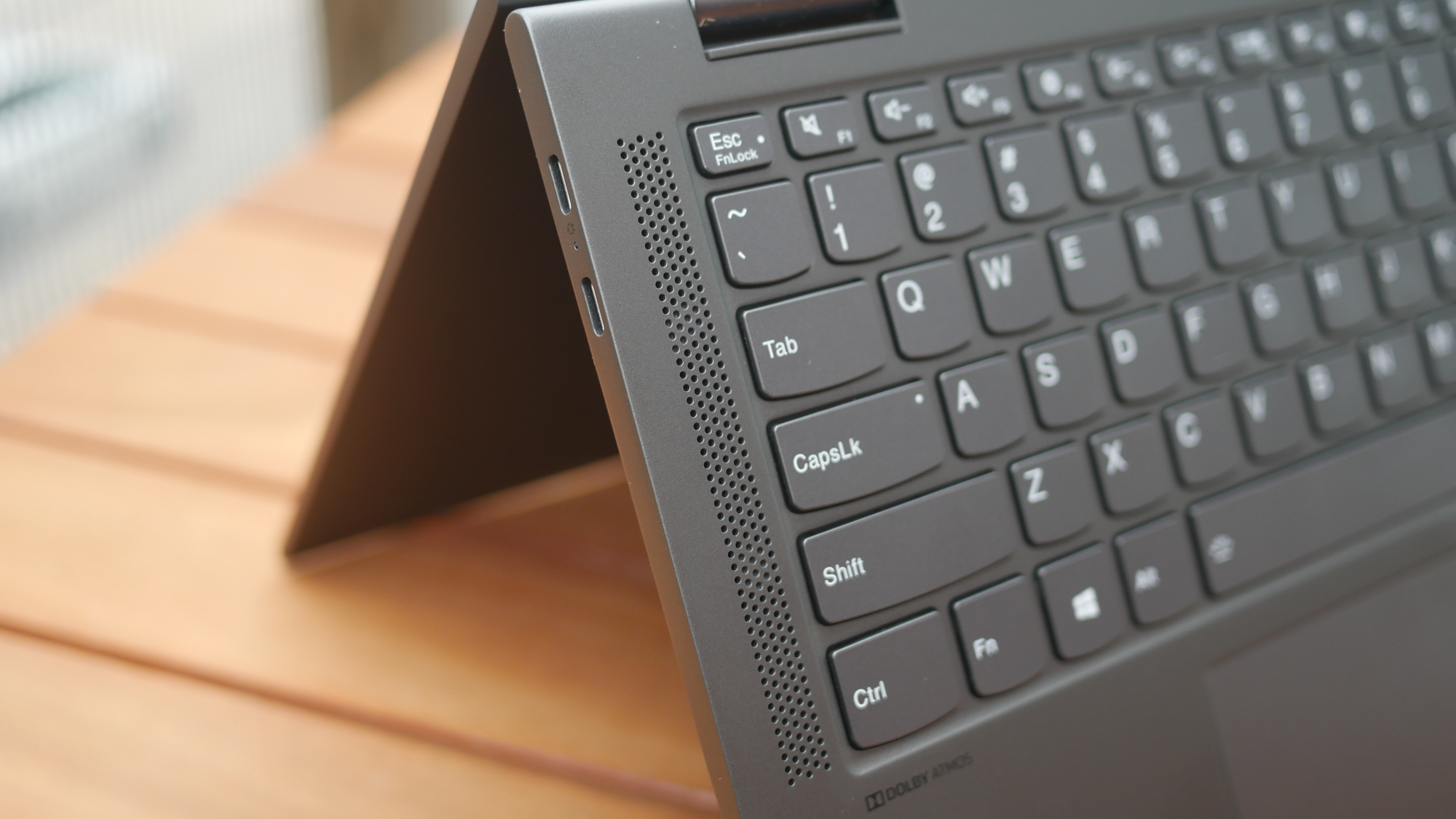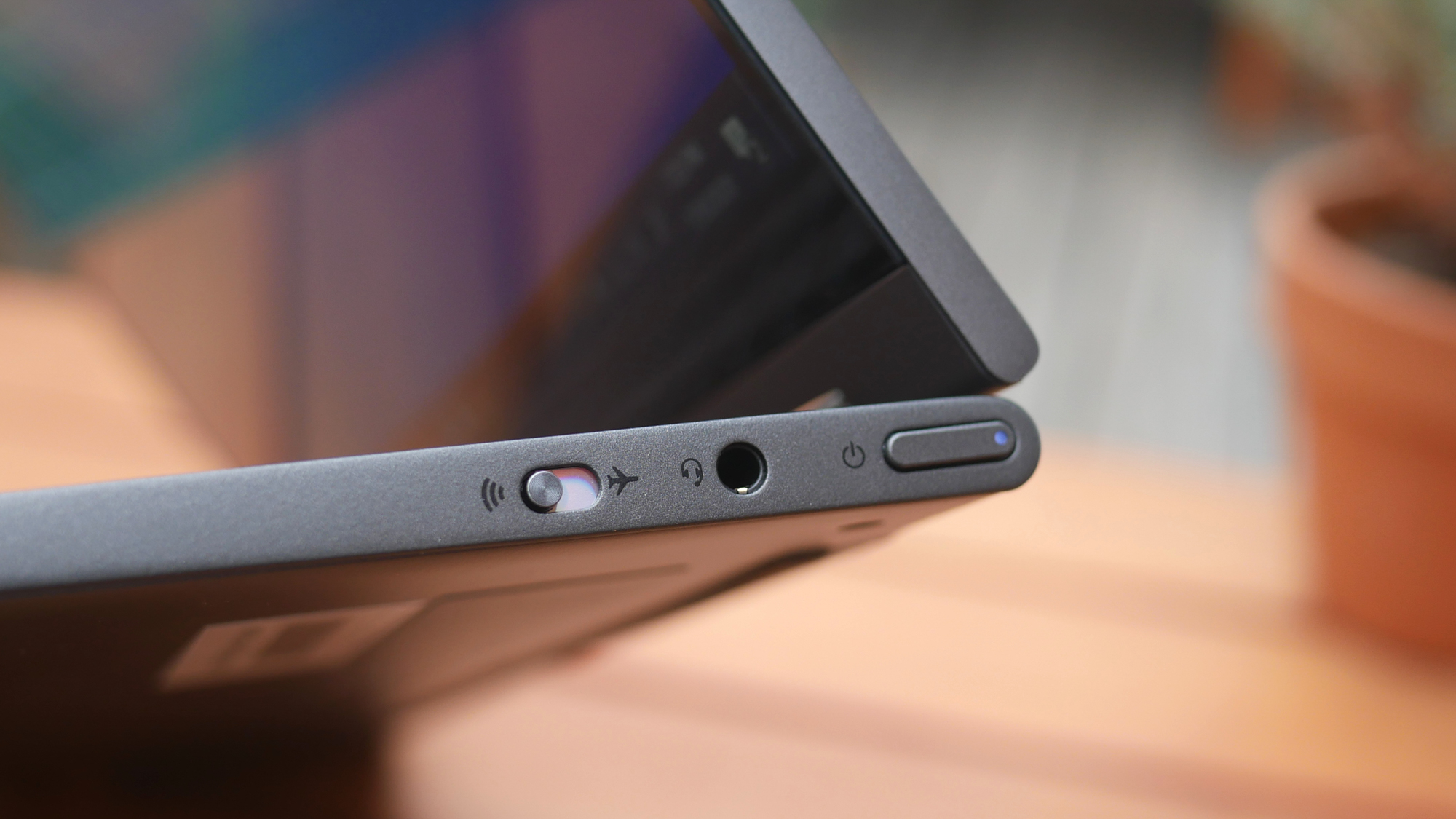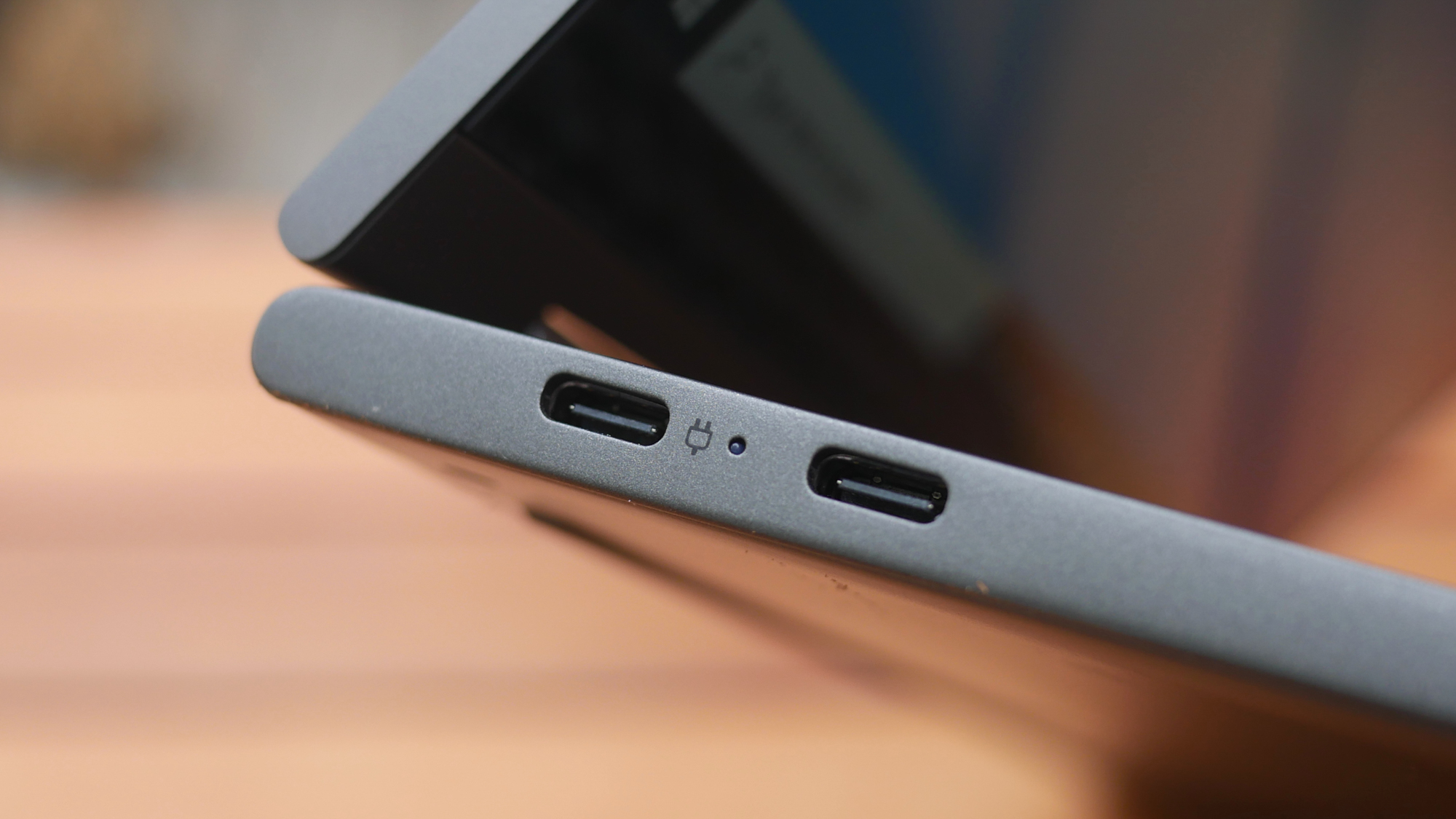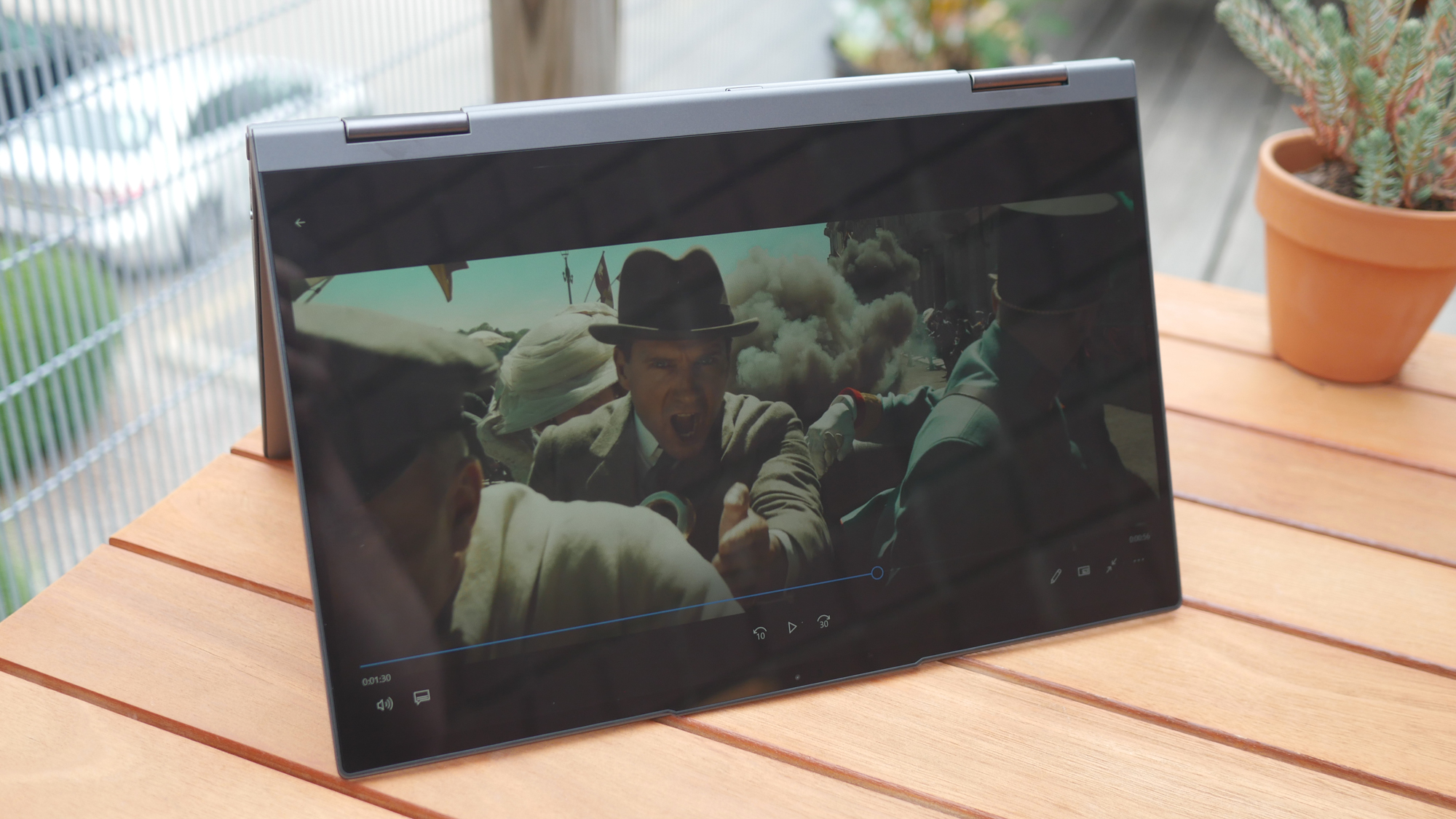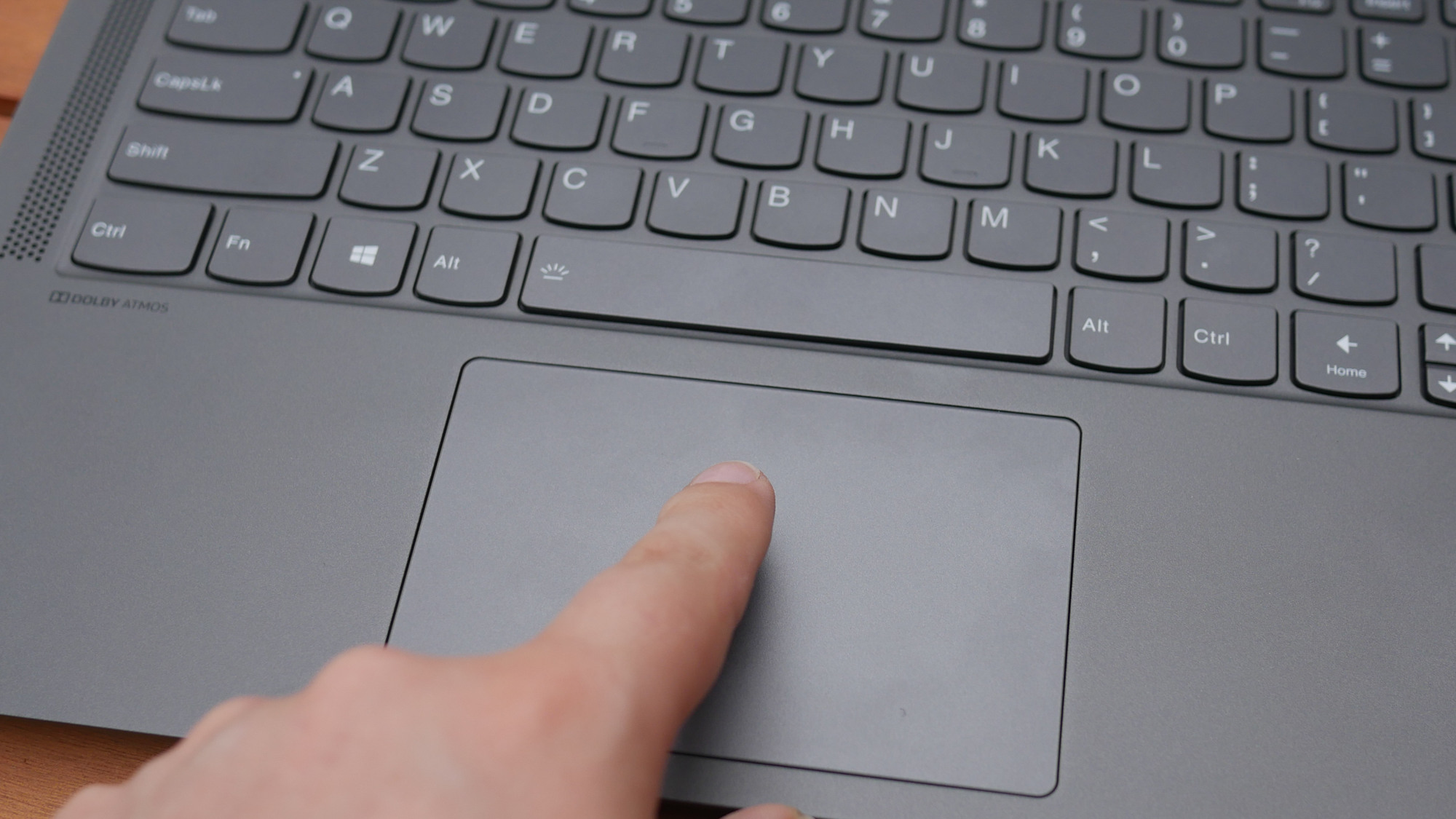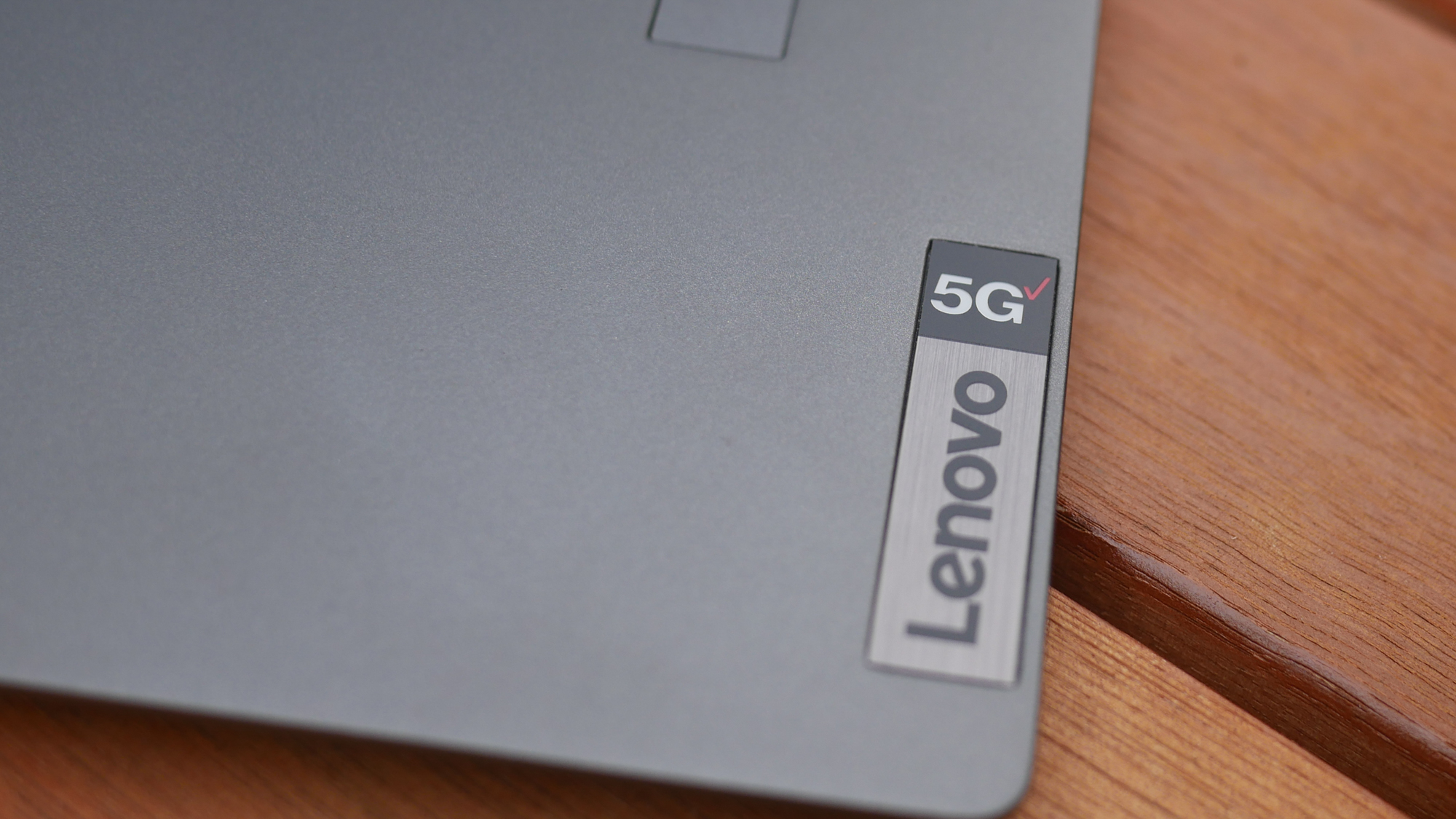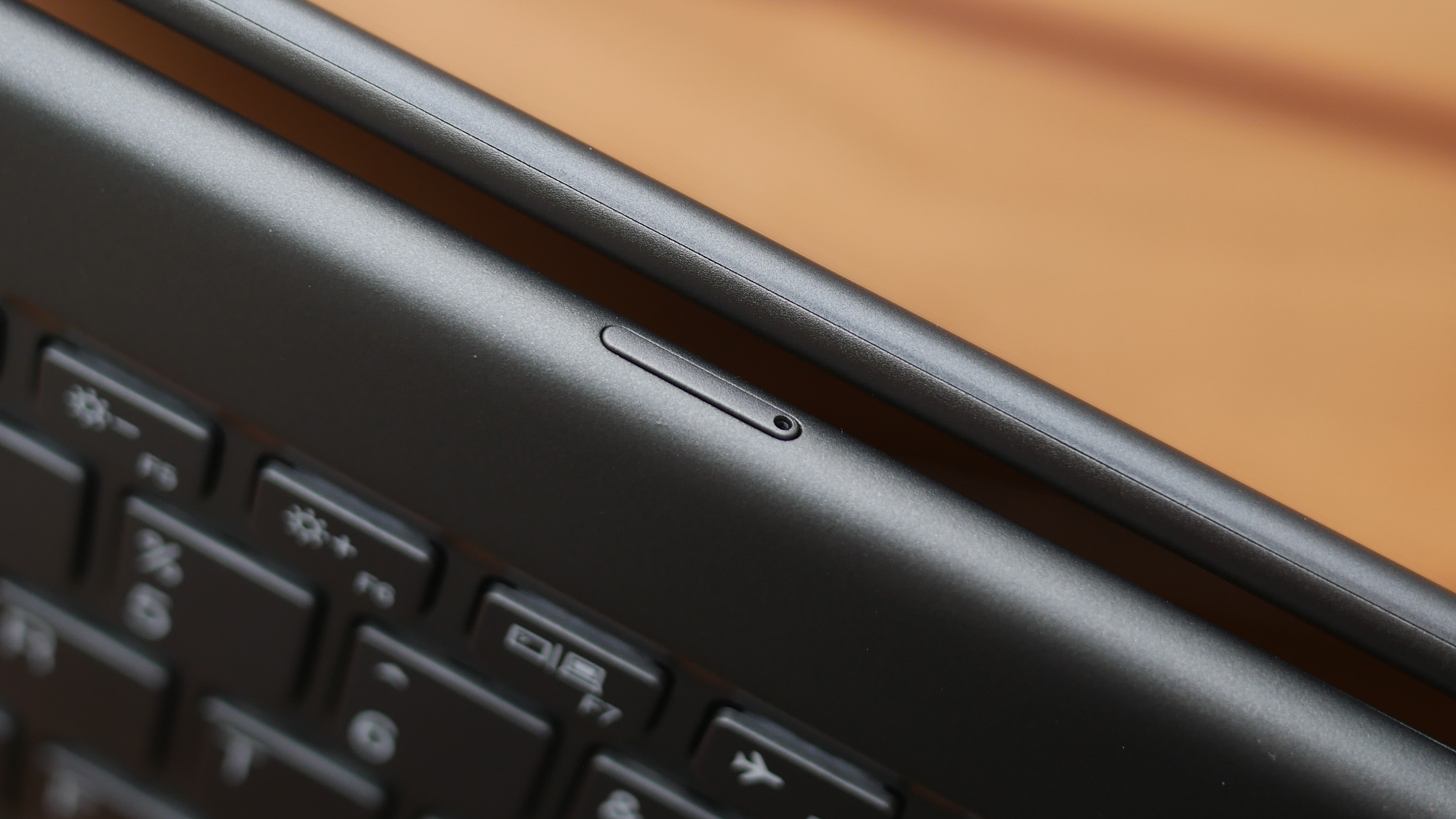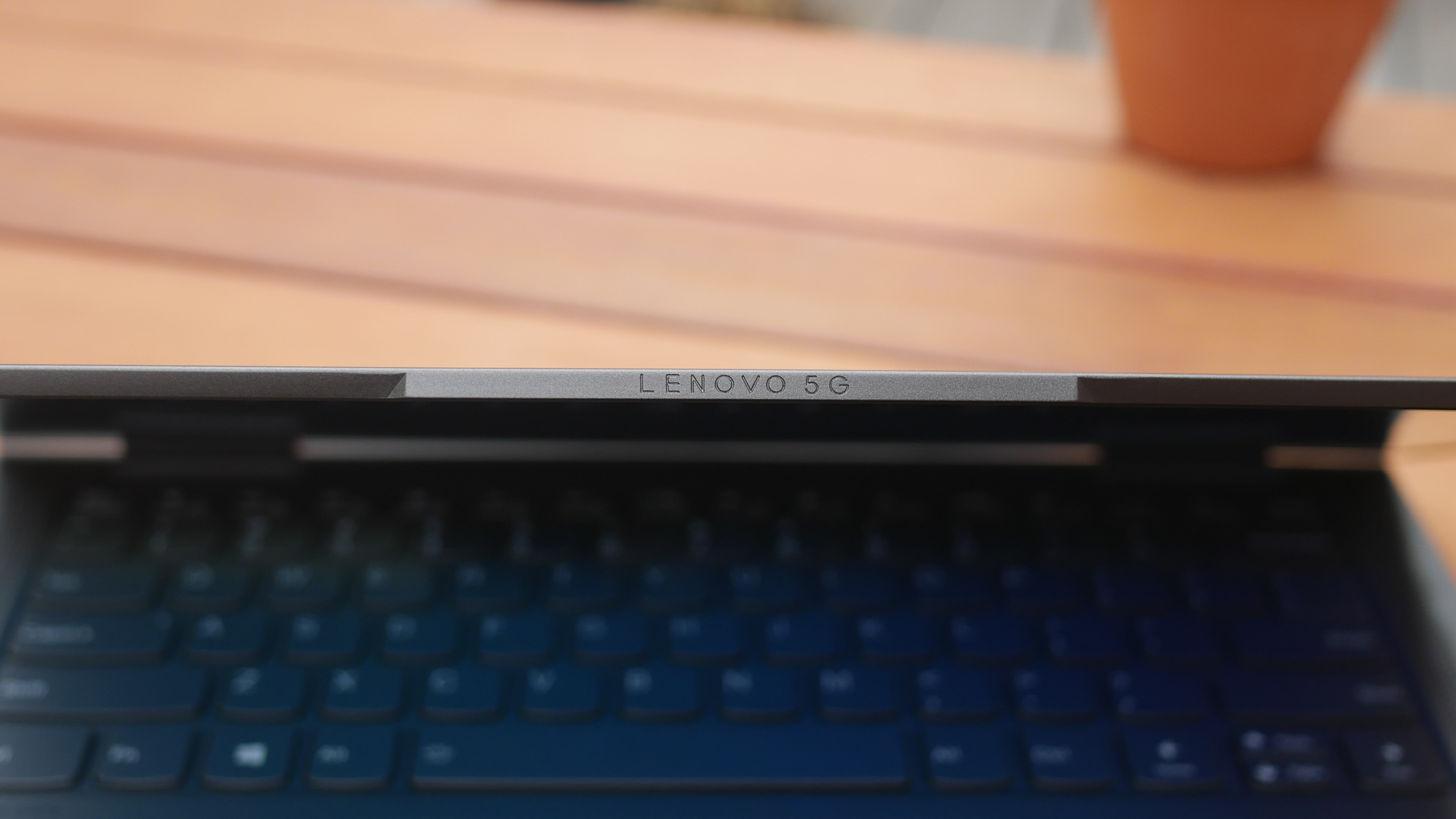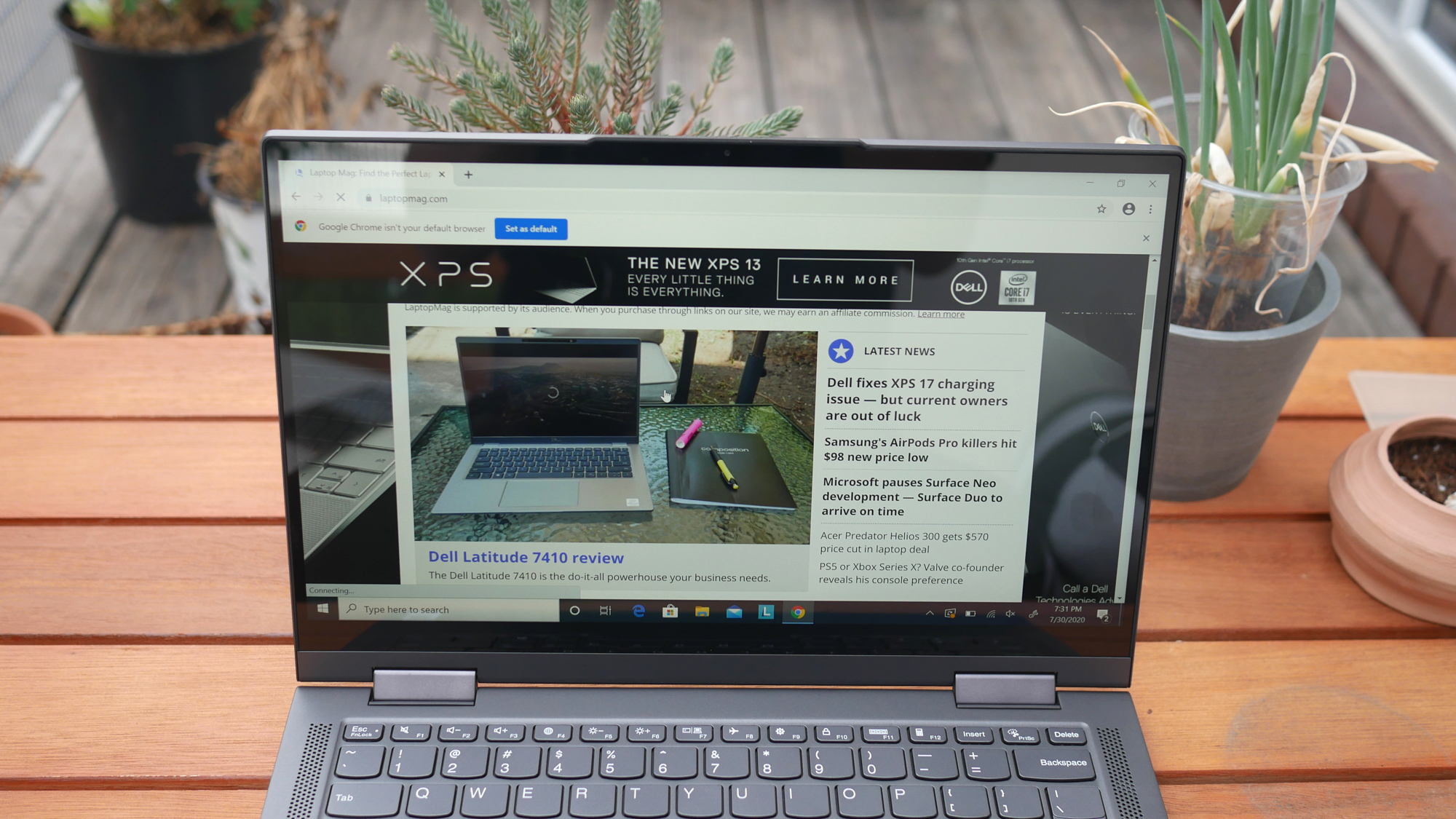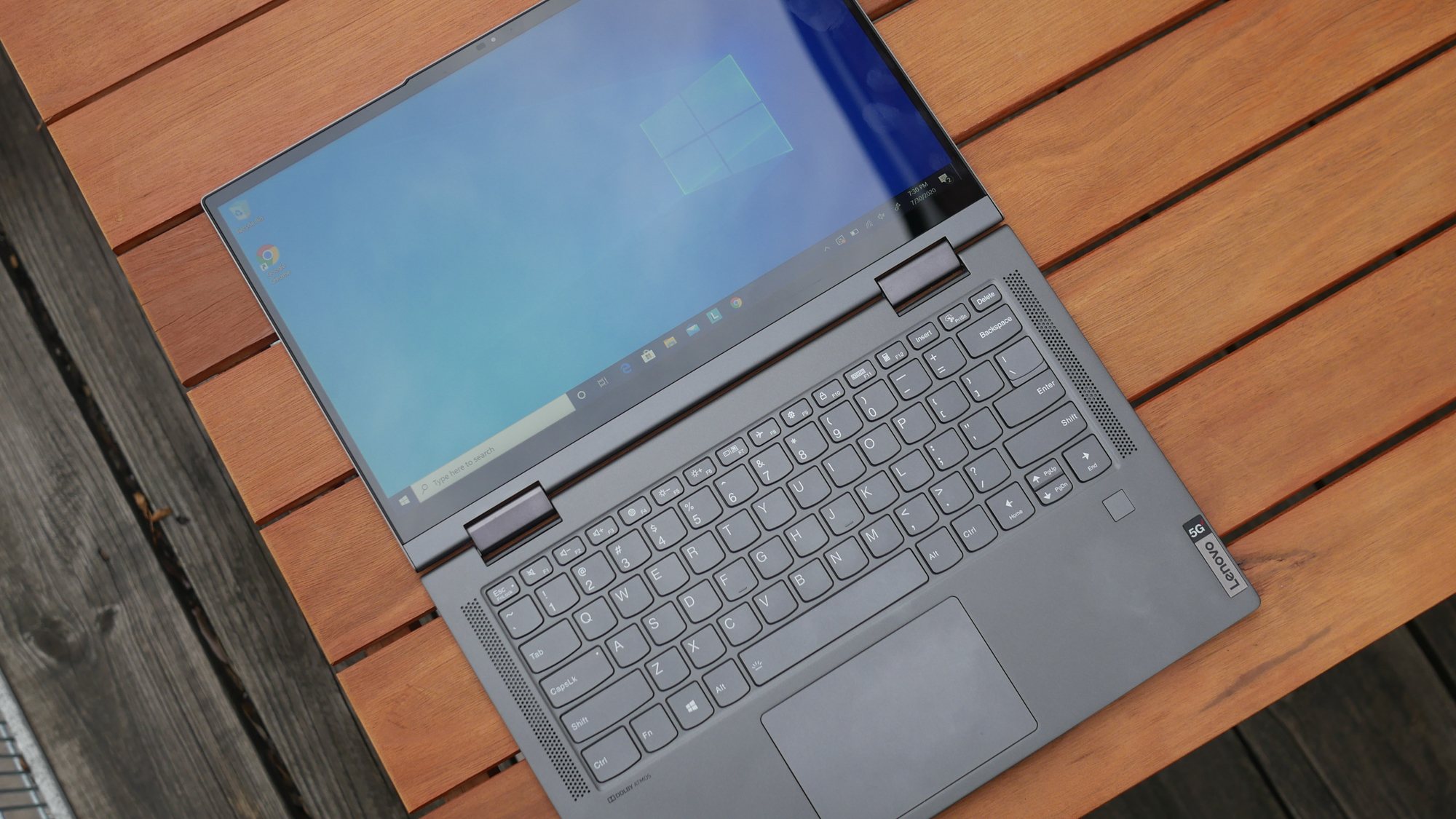Laptop Mag Verdict
Lenovo's Flex 5G is the first laptop with Verizon 5G, but those blistering wireless speeds are counterbalanced by sluggish performance and compatibility issues.
Pros
- +
Record-setting battery life
- +
Verizon 5G support
- +
Lightweight, premium design
- +
Bright and vivid display
Cons
- -
Sluggish performance
- -
Shallow keyboard
- -
App compatibility issues
- -
Pricey
Why you can trust Laptop Mag
Price: $1,499
CPU: Qualcomm Snapdragon 8cx
GPU: Qualcomm Adreno 680
RAM: 8GB
Storage: 256GB SSD
Display: 14-inch, 1080p
Battery: 17:28
Size: 12.7 x 8.5 x 0.6 inches
Weight: 2.9 pounds
Laptops have lagged behind smartphones when it comes to adopting 5G, but that changes with the Lenovo Flex 5G, the first laptop to harness the budding cellular network. Enabling those blistering data speeds is the Qualcomm Snapdragon 8cx, an ARM-based chip built for laptops.
The Snapdragon 8cx delivers better performance than other ARM-based chips we've tested, but it still doesn't hold a candle to Intel or AMD processors, and app compatibility remains a problem. As such, the Flex 5G isn't a good choice for power users. Instead, with its premium, portable chassis and gorgeous display, the Flex 5G should only be considered by those who travel and need internet access away from their home Wi-Fi.
Even then, there are better options available. As it stands, the Flex 5G's flagship feature can only be experienced on certain streets in sections of a portion of US cities. And while the Flex 5G's battery life is nothing short of miraculous, it's not enough to justify the high price, especially when you compare the complete package with others in this price range.
Lenovo Flex 5G price and configuration options
Lenovo sells the Flex 5G in a single configuration. For $1,499 you get a 14-inch, 1080p display, a Qualcomm Snapdragon 8cx processor, 8GB of RAM and a 256GB SSD.
Lenovo Flex 5G design
As the first laptop with 5G, the Flex 5G is no ordinary notebook. And yet, the rather bland chassis would suggest otherwise. While by no means unattractive, the Flex 5G lacks the flashy design elements that elevate the designs of other laptops in this price range.
The Flex is a mix between an IdeaPad and a Yoga, flaunting a sleek aluminum chassis with a minimalist aesthetic. A shiny Lenovo tag on the edge of the lid is the only contrast against the Flex's Iron Gray sheen. Open the laptop, and you'll find the same metallic hue on the deck and keyboard keys.
Flanking the keyboard are two top-firing speakers; below the right grille is a fingerprint sensor and more Lenovo branding, this time with an irremovable Verizon 5G sticker. I don't mind the simple, uniform appearance of the Flex 5G, but some chrome trim or subtle pattern could have given it the spice its lacking.
Sign up to receive The Snapshot, a free special dispatch from Laptop Mag, in your inbox.
Still, the Flex 5G feels more premium than it looks. From afar, you'd expect the Flex 5G to be made entirely of aluminum magnesium but it's not. The bottom half -- the deck and underside -- are coated in a pleasant soft-touch material reminiscent of the plush surface covering the ThinkPad X1 Carbon.
As a 2-in-1 laptop, the Flex 5G can contort into a tablet or be placed in tent mode when you're presenting or watching a video. Like the rest of the laptop, the dual hinges are sturdy, which I discovered when the screen didn't budge after I tapped on it with some force.
At 12.7 x 8.5 x 0.6 inches and 2.9 pounds, the Flex 5G is thinner but heavier than the LG Gram 14 2-in-1 (12.8 x 8.3 x 0.7 inches, 2.5 pounds). HP's Spectre x360 13 (12.2 x 8.6 x 0.6 inches, 2.8 pounds) is about the same thickness and heft while the Lenovo Yoga C940 is about the same size as the Flex 5G (12.6 x 8.5 x 0.6 inches, 3 pounds).
Lenovo Flex 5G ports
There are few ports on the Flex 5G, so add some dongles to your cart before you checkout. Actually, there isn't a single input on the right side apart from a headphone jack and a physical switch for toggling between Airplane Mode (cellular and Wi-Fi turned off) and mobile connectivity.
On the left side are two USB 3.2 USB-C ports, one of which is used for charging.
Lenovo Flex 5G display
The Flex 5G's 14-inch, 1080p display is a good one. The panel gets plenty bright and the colors are more vivid than what you'll find on competing notebooks.
The panel was sharp enough that I could see the pinstriping in the housemaid outfits and in the snazzy suit of Conrad, the new protagonist played by Harris Dickinson in The King's Man. Turquoise blue and peach-orange hues glistened off chandeliers in the grand ballroom scene as radiant greens and reds of gowns and military uniforms stood out against the golden opulence.
Our colorimeter clocked the screen at 115% of the sRGB color gamut, making it brighter than the one on the Gram 14 2-in-1 (108%), the Spectre x360 13 (109%) and the Yoga C940 (104%).
Peaking at 410 nits of brightness, the Flex 5G's panel gets bright enough for outdoor use. It outshone the Gram 14 2-in-1 (306 nits), the Spectre x360 13 (287 nits), the Yoga C940 (339 nits) and the category average (368 nits).
Lenovo Flex 5G keyboard and touchpad
Maybe I got used to typing on the ThinkPad X1 Carbon, or I forgot what to expect from an ultrathin laptop, but the Flex 5G's keyboard isn't my favorite.
The keys are very shallow, which caused me to frequently bottom out. They also feel a bit stiff and I'm missing that audible click heard on tactile keyboards that lets you know when you've actuated a key. On the plus side, the scalloped keys are large, properly spaced, and quiet, so the people around you can concentrate as you tap away.
I typed at 111 words per minute with a 93% accuracy, both of which are below my usual 119-wpm and 95% accuracy averages.
The touchpad underneath the keyboard works well. It has a pleasant smooth surface and is a decent size, at 4.1 x 2.8 inches. Precision drivers ensured that my wipes and Windows 10 gestures were executed without a fault.
Lenovo Flex 5G audio
The top-firing speakers on the deck of the Flex 5G sound decent. While they don't get crazy loud, my medium-sized bedroom was filled with Brandon Flower's voice when I listened to The Killers' "My Own Soul's Warning" at maximum volume. Then again, you won't want to crank it up too loud because you might hear a distorted hiss in the treble. That grating noise disappeared at 75% when the speakers found their footing; at this volume, the treble sounds were slightly harsh but the vocals were crisp and the midrange sounded smooth.
Lenovo Flex 5G: 5G speeds
The Flex 5G is the first laptop to support 5G mobile connectivity. 5G is the next generation of cellular networks (following LTE) designed to deliver blistering fast internet speeds, among various other benefits.
The Flex 5G uses Verizon's 5G network exclusively and has antennas for both mmWave and Sub-6Ghz technology, which means you'll get the fastest speeds and widest coverage. Our experience testing 5G in various cities was promising but inconsistent.
My first test was in Cincinnati, just across from the Reds' baseball stadium on one of the very few strips of 5G coverage available in the city. I ran three speed tests while standing in the same spot and got three very different results. My first attempt was the slowest with the Flex 5G hitting "only" 370 MBps. Subsequent tests reached 455.6 MBps and a blistering 1.3 Gbps -- faster than some of the quickest home Wi-Fi.
The fine folks at our sister site, Tom's Hardware, said the best speeds they hit in New York City were 250 Mbps, lower than the slowest I saw in Cincy. All this proves is that 5G still has a way to go before we consistently get the numbers promised by mobile carriers.
Verizon has the most established 5G network, now available in more than 30 cities. You can find out whether 5G is live in your area by visiting Verizon's website. I need to emphasize that 5G is still in its infancy; the network will expand to more areas and become faster and more reliable over time.
Lenovo Flex 5G: ARM compatibility
Before we talk about performance, it's important you know the limitations of the Flex 5G's Snapdragon CPU. Because it's based on ARM, the Flex 5G can't run every program supported by Intel and AMD-powered laptops.
The Snapdragon 8cx is a 64-bit ARM processor, so it can natively run 64-bit, ARM64 apps and 32-bit, ARM32 apps. It can even run 32-bit x86 apps, but only through an emulator (called WOW64), which can hurt performance. What the Flex 5G can't run are 64-bit, x86 apps.
With that in mind, if there is a program you need that is only available as a 64-bit app, you can't run it. The good news is that many apps have 32-bit versions (including web browsers like Google Chrome), so most people won't run into problems during day-to-day tasks.
It's those few apps without 64-bit versions that are a deal-breaker for some. The Dropbox desktop app, for example, isn't compatible with ARM processors, so you need to use the watered-down Dropbox for S mode app. Plex won't install but Audacity does natively. Most Adobe programs work via the 32-bit emulator, others, like Adobe XD, don't. The same goes for video games; most will run on an emulator but with varying stability.
The list goes on and on, so you'll want to really think about which apps you need and determine whether they will run on the Flex 5G. Fortunately, some folks on Reddit put together a useful spreadsheet outlining which apps do and don't run on ARM.
Lenovo Flex 5G performance
Don't expect the Flex 5G to perform as well as other $1,500 laptops. At least, not those with Intel or AMD processors. Armed with a Qualcomm Snapdragon 8cx chip and 8GB of RAM, the Flex 5G struggled to load a dozen tabs in Chrome, a browser it runs via emulation. My browsing experience improved once all the tabs had loaded and I was working on one at a time. After learning the Flex 5G's limits, I watched a YouTube video while flipping through a few tabs without any issues.
There's no way around it, the Flex 5G's price-to-performance ratio is ugly. While an improvement over previous AMD-powered laptops, the Lenovo was decimated by competitors in our benchmark tests. The Flex 5G scored a 2,779 on the Geekbench 5.0 overall performance test, falling well short of the Gram 14 (Core i7-10510U, 3,321), the Yoga C940 (Core i7-1065G7, 4,055) and the average premium laptop (4,061).
The Flex 5G is equipped with a 256GB UFS 3.0 flash storage drive, not a proper SSD. It showed in our tests when the Flex 5G needed 19 seconds to duplicate a 5GB file for a rate of 270.7MBps. That's slow compared to the Gram 14 2-in-1 (1,454.1 MBps), Spectre x360 (391.5 MBps) and the Yoga C940 (1,017.9 MBps). The average is 681.5 MBps.
Lenovo Flex 5G graphics
Don't try to play games on the Flex 5G. Even if the Qualcomm Adreno 680 supports what you're playing, it probably won't have the power to run it.
The Flex 5G played Dirt 3 (High, 1080p) at 21 frames per second, stalling before it hit our 30-fps playability threshold. The Gram 14 2-in-1 (34 fps, Intel UHD), Spectre x360 13 (56 fps, Intel UHD) and Yoga C940 (55 fps, Iris Plus) all accelerated past the Flex 5G.
Lenovo Flex 5G battery life
Congratulations Flex 5G, you now hold the record as the longest-lasting laptop we've ever tested. Aided by the Snapdragon 8cx, the Flex 5G lasted for 17 hours and 28 minutes on our battery test, which consists of browsing the web over Wi-Fi at 150 nits of brightness.
How impressive is that really? The average premium laptop lasts for 9 hours and 28 minutes on a charge, so any laptop with over 10 hours of runtime earns our praise. 17 hours and 28 minutes of runtime means the Flex 5G will stay powered from liftoff to touchdown on the longest intercontinental flights.
Even the best of its competitors can't outlast the Flex 5G. The Gram 14 2-in-1 endured for an impressive 14 hours while the Spectre x360 13 and Yoga C940 also breached the 10-hour mark, at 12:07 and 11:46, respectively, but got nowhere near the Flex.
Lenovo Flex 5G webcam
Owning a laptop with a good webcam is more important than ever now that so many people are working from home. The 720p camera on the Flex 5G works in a pinch, but an external webcam will deliver a much better image. My biggest qualm with the selfie I shot in my dimly-lit apartment was the lack of color in my face.
If my ghostly white face were my actual skin tone, then I'd need to rush to the hospital (although my pale complexion suggests it's already too late). As for details, they're fine; I could see the reflection from a nearby window in my eyes but my beard was a dark blob.
Lenovo Flex 5G heat
Like a well-trained athlete, the Flex 5G didn't even break a sweat after we subjected it to our heat test, which involves playing a 15-minute, 1080p video. The touchpad was a cool 74 degrees Fahrenheit while the center of the keyboard only reached 77 degrees. You can even use the Flex 5G on your lap without any discomfort because the underside warmed to 83 degrees, well below our 95-degree comfort threshold.
Lenovo Flex 5G software and warranty
Lenovo did a great job condensing the software tools it provides to customers into one tidy app called Lenovo Vantage. In Vantage, you can check your warranty details, backup and restore files, and reset Windows 10. Unfortunately, you don't get the full x86 features, so there is no way to install the latest drivers or get support directly from the app.
Also installed on the Flex 5G is your standard buffet of Windows 10 Home bloatware, including Farm Heroes Saga, Hulu and Netflix.
The Flex 5G ships with a one-year warranty. See how Lenovo did our Best and Worst Brands and Tech Support Showdown special reports.
Bottom line
I like the Flex 5G as an always-connected device for everyday tasks on the go. Along with futureproofing, the 5G antennas in the Flex 5G means you'll never go without internet access, which can't be said about its stuck-at-home Wi-Fi-only rivals. And with record-breaking battery life of more than 17 hours, you don't need to haul around the power brick.
But what makes the Flex 5G such a compelling laptop is also its downfall. The Qualcomm Snapdragon 8cx chip powering this 2-in-1 can't keep up with the top Intel or AMD-powered notebooks, and you still can't run certain programs on ARM. Moreover, the Flex 5G's keyboard is shallow and it has only two USB-C ports.
The biggest problem, however, is the price. If the Flex 5G were, say, half the price, it'd be a great secondary device to a more powerful, stationary laptop or desktop. But there just aren't a lot of people willing to spend $1,499 on a companion laptop. If you need 5G speeds today, the Flex 5G is the only available option and a good one for basic tasks. If you don't, we recommend buying either a top LTE-enabled laptop, like the Spectre x360 13, or waiting for 5G to reach its full potential because, while the Flex 5G is the first 5G laptop, it certainly won't be the last.
Lenovo Flex 5G Specs
| Size | 12.7 x 8.5 x 0.6 inches |
| Display | 14-inch, 1080p |
| CPU | Qualcomm Snapdragon 8cx |
| Price | $1,499 |
| GPU | Qualcomm Adreno 680 |
| Battery | 17:28 |
| Weight | 2.9 pounds |
| Storage | 256GB SSD |
| RAM | 8GB |
Phillip Tracy is the assistant managing editor at Laptop Mag where he reviews laptops, phones and other gadgets while covering the latest industry news. After graduating with a journalism degree from the University of Texas at Austin, Phillip became a tech reporter at the Daily Dot. There, he wrote reviews for a range of gadgets and covered everything from social media trends to cybersecurity. Prior to that, he wrote for RCR Wireless News covering 5G and IoT. When he's not tinkering with devices, you can find Phillip playing video games, reading, traveling or watching soccer.
